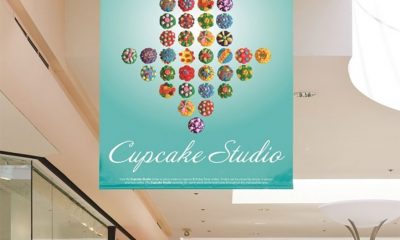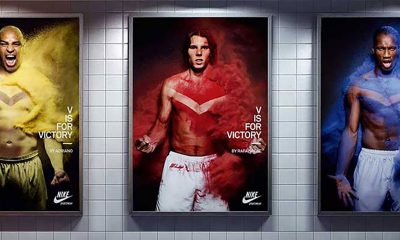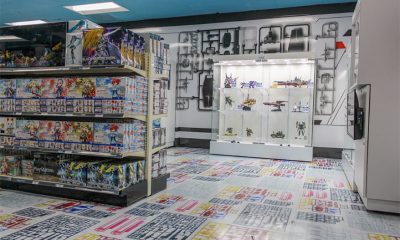Banners + Awnings
Banner Banter
A 20-shop survey reveals trends in the banner business
Published
18 years agoon
"If I could do only one thing, I'd produce banners because they're easy to work with," comments Bea Wilson of Sign Here. Working with banners may be easier than surveying the shops that make them, we discovered through this informal banner survey.
We randomly chose 20 shops from respondents to our 1999 survey of banner usage and asked them additional questions about their banner production. In total, we surveyed six commercial, seven vinyl, five commercial/electric and two franchise shops.
The variety of shops questioned gave a fair representation of the various facets of the banner-making industry. Included with the numbers provided here are owners' comments and insights into banner production. We hope that our results spark ideas.
Commercial shops
One of the most common types of shops, the commercial shop, as we define it, handles many sign types except electric signs. Our commercial respondents average 18.5 years in the business and 20 employees per shop. Commercial shops generally take orders of one banner per order.
Commercial respondents also say 16.67% of their $1,136,000 sales volume is banner sales. Commercial shops complete these orders with a relatively large number of employees, averaging 20 employees per shop.
AdvertisementCommercial/electric shops
According to our survey, full-service commercial/electric shops handle a variety of orders from nylon banners to nylon marquees. Respondents have been in business an average of 43.2 years, the oldest in the survey. These shops take orders averaging five banners per order, but can handle bigger order sizes.
Commercial/electric shops produce some of the largest banners, but generally banner orders constitute 5.2% of a $2,585,000 average per year sales volume. This may be diluted by the large number of employees in the commercial/electric shop–an average of 22 people. Interestingly, despite this high number of employees, we did talk to a commercial/electric shop with only one employee.
Vinyl shops
Vinyl shops typically take larger orders compared to franchises or commercial/electric shops, averaging six banners per order. Banners constitute a larger percent of sales volume, 21.8% of a $222,000 average sales volume. A typical vinyl shop averages four employees.
Franchises
AdvertisementThe two franchises surveyed handle a wide range of customers, mostly those wanting just one banner. However, one franchise produced banners in an order for 250 banners.
Respondents typically don't produce large-format banners, but those costing between $130-$200. Franchises attribute a high percent of their sales volume to banners, from 20%-30%, and often make between $270,000 and $450,000 a year in sales volume with only 4-7 employees.
Pricing, sales and trends
The average price shops charge is $158.75 per standard-sized banner, or $7.50 per sq. ft. However, prices range from $1.50 to $17 per sq. ft.
Although we surveyed shops in sales volume ranging from $25,000 to $7 million, shops average $1,147,000 in sales, with 16.45% attributed to banners. These shops average 12 employees, but range from one-man shows to 67-employee giants.
One category we could not account for, or contact, was the rising number of home businesses that handle banner production. "Pricing in this area has gotten competitive," says Jenni Burns of Bell Signs. "We are now competing with home businesses, which can offer a much lower price because they specialize." One of Jenni's daily concerns is maintaining employee relationships while competing with other shops.
AdvertisementHalf of respondents report an increase in banner sales in 2000 from 1999, while 45% report an equal amount of business for both years. Only one vinyl shop, Rapid Sign Systems, report its banner business is decreasing, although its total sales volume is increasing.
Do you want fries with that?
Overall, shops report an average size order of three banners, but 40% say their orders are generally for a single banner. The largest order, for 300 banners, is reported by Art Display Co. Inc., a 67-employee commercial shop. The survey shows most of the large orders (200 or more banners per order) are handled by companies with no less than 40 employees. One notable exception was 12-year old Sign*A*Rama, a seven-employee shop that handled a 250-banner order.
Thirty-five percent report their most common banner ordered is 3 x 8 ft.; 25% say 3 x 10 ft.; and 15% report 4 x 8 ft. The largest banner made by the companies we surveyed was 75 x 225 ft., created by Holthaus Sign Co. On average, the largest banner produced by respondents is 17 x 54 ft.
Ageless shops, ageless signs
In the mix of shops we surveyed, the average shop age is 20.7 years. The granddaddy is 102-year old Cook Sign Co., followed by 71-year old Holthaus Signs Co., and 52-year old Art Display Co. The youngest business is two-year old Frontline Signs. Commercial/electric shops lead the average number-of-years-in-business category at 43, while commercial shops average 18 years in business, vinyl at 10 and franchises report 8.
Many companies say they expect their banners to last from one month to several years, but this depends greatly on the banner's purpose, installation and storage. For example, if a banner will be used for a week-long event, then rolled up and stored for the next year, several shops recommend the banner be cleaned, dried and stored in a cool, dry place. In our survey, the oldest banner the shops report is six years old.
In-house vs. outsourced
All respondents decorate some or all of their own banners in-house. Sixty-five percent (13 of 20) produce all banners internally, but one $5 million shop reports 20% in-house production, compared to 80% purchased from wholesalers (banners constitute only 3% of their business). Another company buys 39% of its banner work wholesale, compared to six companies with an 18% wholesale average and two shops that subcontract 21%. These numbers give you a picture of the prevalence of in-house work.
This mirrors the 1999 banner survey, in which 59% of companies reported they decorate all banner work, while 25% subcontracted and 22% purchased banners wholesale.
Vinyl Rules
It's no surprise that vinyl rules with all respondents, both as a substrate (84% average) and decoration method (93%).
Seventy-five percent (15 of 20) use vinyl as a substrate for at least 75% of their banners, with six shops using it exclusively. Canvas, nylon, polyethylene, polyester, paper and canvas are noted as infrequent alternatives.
As a decoration method, vinyl comprises the lion's share: 60% (12 of 20) use it for all banners and 85% (17 of 20) use it for more than 90% of banner jobs. It makes little difference if a company records sales of millions of dollars or less than $100,000–vinyl remains the decoration method of choice.
Digital printing continues to make inroads, averaging 17% usage with 55% (11 of 20) of shops, while paint is used by 30% (6 of 20) for 16% of their banner jobs. Screenprinting is used sparingly by three shops.
Inherit the wind
Listen to the experts, respondents say to customers. Richard Burn of Michigan Signcrafters says, "We give customers good instructions about installation, but sometimes they don't follow our advice. One customer who didn't properly gusset his banners found they tore to pieces very quickly."
Wind is a major problem for customers of Custom Neon and Vinyl in Topeka. Owner Todd Schaffer notes that a bad wind usually moves or destroys an improperly installed display. "Some people cut a half-moon in the banner to compensate for the wind," Schaffer says, "but we don't do that because the cut causes the vinyl to crease when it's rolled up. Also, it's distracting to see a cut in a banner. Instead, we produce banners with more weight and insert more grommets."
While attending the annual workshops at Advantage Sign Supply (Grand Rapids, MI), Richard Burn Learned new installation techniques, but divulges to us one of this time-tested tips. "We use ceramic-coated desk screws for installation because they come out more easily than galvanized screws," he says. "We also hide the screws using a piece of vinyl on top of them."
Marketing for a banner year
Several shops say the biggest problem they have is keeping up with current business–meeting deadlines, keeping customers happy and basically getting everything out the door on time.
For 10 years, Don Bartley has operated his commercial shop, Signs & Wonders, and he knows that it's difficult to juggle jobs by himself. He finds that as the number of banner jobs fluctuates, the demand for long-term banners has increased. "The main problem for a small shop like mine is scheduling–trying to get things done on time is a challenge."
Offering one solution, Carole Allen of Art Display Co. says her company often looks around when ordering from and outsourcing to other companies. She also uses the Internet as a resource. "One plant might be busy, while another might be in a lull. Shop around," she says.
Full-service Cook Sign Co. usually handles sign systems but will produce large, long-term banners for customers. Bernie Dardis of Cook says, "This is part of our marketing plan to grow as a sign company. Large banners can last two to three years with lamination and UV-durable or resistant coating."
Mark Goodson, owner of Goodson Signs, says increasing sales volume is his biggest concern. "I've got the space, I've got the equipment, and I can get the bodies to fill the shop, but that's tricky when it comes to design and painting." Mark says his solution will be to conduct market research, distribute mailings or hire a salesman.
Materials of choice
Seventy-two percent (13 of 20) of surveyed shops name more than one banner-material manufacturer or supplier. Twenty-five companies all mentioned: Advantage Sign Supply (3); American Banner (2); Gregory Inc. (3); Ameriban (2); N. Glantz & Son (2); 3M Industrial Adhesives & Tapes Div. (2); and one each for Affordable Signs and Banners, Aksarben, Apache Banner, The Banner Shop, Best Buy Banner, Creative Banner Assemblies, Diamond Neon Supply, Eastern Banner, Harbor Sales Co., Hewlett-Packard, Imperial Wholesale Banner, Kapco Graphic Products, Montroy Supply Co., New England Sign Supply, Regal Plastic Supply, Southland, Spartan International, Sugar House Banners & Awnings and Texas Screenprinting.Gregory Inc., N. Glantz & Son, 3M Industrial Adhesives & Tapes Div., Creative Banner Assemblies, Diamond Neon Supply, Harbor Sales Co., Hewlett-Packard, KAPCO, Montroy Supply Co., Regal Plastic Supply,
A $7 million company buys only 3M's 13-oz. vinyl and a $3 million shop orders only from Affordable Signs & Banners, whereas a $5 million company searches for whomever offers the best deal. Keith Newsome of Distinctive Designs says, "We refuse to use cheap vinyl; ours has a five-year warranty."
Obviously this trend has spread from coast to coast. "Usually shops have problems with clients who want double-sided banners but also use the non-receptive side for a message," says Jim and Liz Alcauskas of Fastsigns. "They're surprised when the vinyl comes off. We always use premium vinyl, so we don't have that much of a problem with it."
Melody Driscoll of Frontline Signs says for a double-sided banner you have to use premium vinyl, but she also recommends the long-standing trick of roughing vinyl with Ajax® or another abrasive cleaner for better adhesion.
Whatever materials are ordered, respondents say orders are filled within a day or two for 90% (18 of 20) respondents, but some could have same-day service, while two shops claim two to three weeks turnaround time for custom orders.

SPONSORED VIDEO
Introducing the Sign Industry Podcast
The Sign Industry Podcast is a platform for every sign person out there — from the old-timers who bent neon and hand-lettered boats to those venturing into new technologies — we want to get their stories out for everyone to hear. Come join us and listen to stories, learn tricks or techniques, and get insights of what’s to come. We are the world’s second oldest profession. The folks who started the world’s oldest profession needed a sign.
You may like

5 Reasons to Sell a Sign Company Plus 6 Options

21 Larry Albright Plasma Globes, Crackle Tubes and More

Orbus Celebrates Earth Day With Recycling Achievements
Subscribe

Bulletins
Get the most important news and business ideas from Signs of the Times magazine's news bulletin.
Most Popular
-

 Tip Sheet1 week ago
Tip Sheet1 week agoAlways Brand Yourself and Wear Fewer Hats — Two of April’s Sign Tips
-

 Photo Gallery3 days ago
Photo Gallery3 days ago30 Snapshots of the 2024 ISA Sign Expo
-

 Ask Signs of the Times5 days ago
Ask Signs of the Times5 days agoWhy Are Signs from Canva so Overloaded and Similar?
-

 Real Deal2 weeks ago
Real Deal2 weeks agoA Woman Sign Company Owner Confronts a Sexist Wholesaler
-

 Benchmarks1 week ago
Benchmarks1 week ago6 Sports Venue Signs Deserving a Standing Ovation
-

 Photo Gallery4 hours ago
Photo Gallery4 hours ago21 Larry Albright Plasma Globes, Crackle Tubes and More
-

 Women in Signs2 weeks ago
Women in Signs2 weeks ago2024 Women in Signs: Megan Bradley
-

 Women in Signs1 week ago
Women in Signs1 week ago2024 Women in Signs: Ashley Borell










